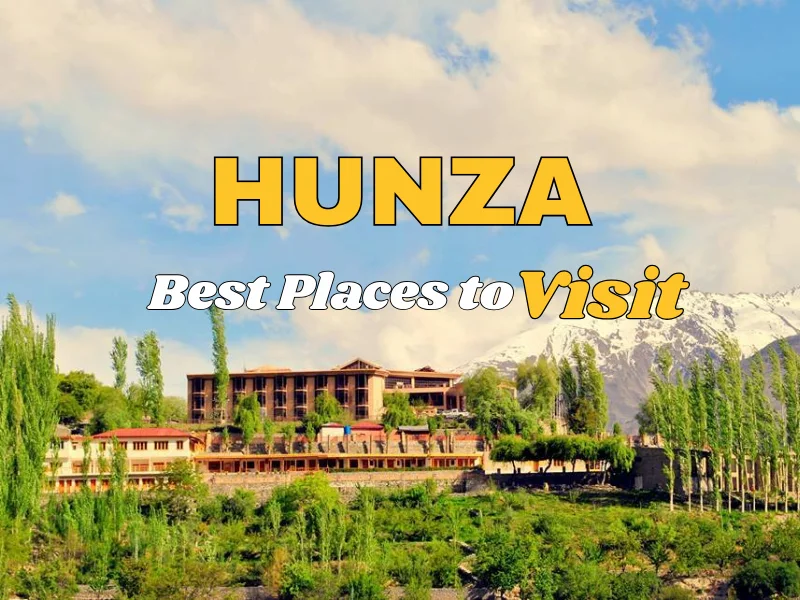Hunza Valley is located in the mighty Karakoram Range of northern Pakistan. Hunza is a paradise on Earth. Famous for its breathtaking views, ancient history, and warm hospitality, this remote valley is a dream destination for travelers from around the world.
Whether you’re a history lover, nature enthusiast, or an adrenaline junkie, Hunza has something special for everyone.
In this guide, you will explore the best places to visit in Hunza, from beautiful and ancient sites to adventurous spots that will leave you spellbound.
So, pack your bags as we take you through the most famous, must-visit, and tourist attractions in Hunza Valley.
Book tour packages us with:
Best Historical Places to Visit in Hunza Valley
Step back in time as you explore Hunza’s most iconic historical gems. These ancient forts and villages are not just buildings, they’re living stories of royalty, resilience, and rich cultural heritage.
1- Baltit Fort – A 700-Year-Old Legacy

One of Hunza’s most iconic landmarks, Baltit Fort sits proudly above Karimabad town. This ancient structure, over 700 years old, once served as the royal residence of the Hunza rulers.
Built in Tibetan architectural style, the fort offers panoramic views of the valley and snow-covered peaks.
Inside the fort, you’ll find preserved rooms, artifacts, and wooden balconies that speak volumes about Hunza’s royal history. Guided tours provide deep insight into its past and cultural significance.
History of Baltit Fort
- Originally built in the 8th century A.D. as a defensive fort with a single stone and timber tower
- Became the royal residence of the Mirs (rulers) of Hunza after the 16th century
- Expanded over time with multiple rooms and floors to suit royal life and defense
- Abandoned in 1945 when the royal family moved to a modern palace
- Fully restored in the 1990s by the Aga Khan Trust for Culture
- Now operates as a heritage museum and cultural center
Architecture of Baltit Fort
Baltit Fort combines Tibetan, Balti, and local Hunza architecture.
- Built on a man-made platform on a cliff edge below Ultar Glacier
- Constructed using stone, timber, and mud – earthquake-resistant design
- Designed with three main floors:
- Ground Floor: Storage rooms and utility areas
- First Floor: Central living space with a large hall
- Second Floor: Audience hall, kitchen, dining area, and guest rooms (used in winter)
- Third Floor: Summer rooms including royal bedroom, dining area, and reception room
Interesting Facts
- Built in the 8th century A.D.
- Blends Tibetan, Balti, and Hunza architecture
- Located on a cliff under Ultar Glacier in Karimabad
- Earthquake-resistant wooden frame construction
- Former royal residence of the Hunza Mirs until 1945
- Now a museum and cultural heritage site
- On UNESCO’s World Heritage Tentative List
- Offers 360° panoramic views of the Karakoram mountains
- Hosts cultural festivals and promotes local traditions
Why Visit?
- UNESCO World Heritage Tentative List
- Stunning views of Ultar Sar and Ladyfinger Peak
- Deep dive into Hunza’s ancient past
2- Altit Fort – Birthplace of Hunza’s Royal Heritage
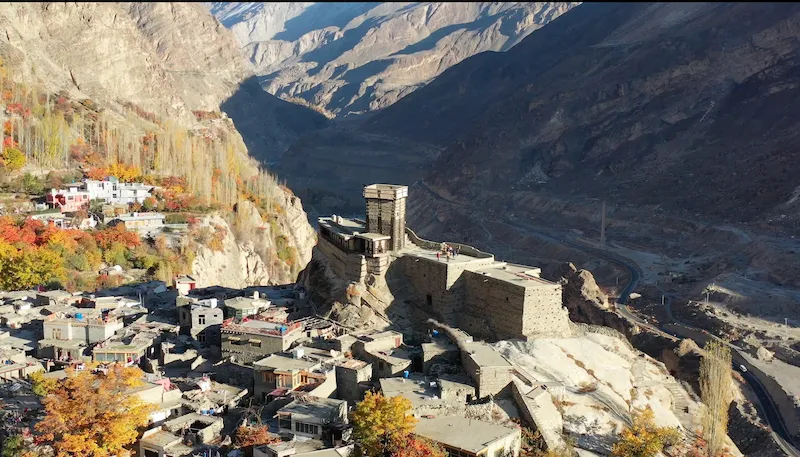
Altit Fort is a 1100-year-old heritage site located in Altit village, near Karimabad in Hunza Valley, Gilgit-Baltistan. Built in the 11th century by the Mir (ruler) of Hunza, it is believed to be the birthplace of the Hunza kingdom and is one of the oldest forts in Pakistan.
Even older than Baltit Fort, Altit Fort is believed to be over 1100 years old. It was the original seat of power before the royal family moved to Baltit. Restored with support from the Aga Khan Trust for Culture, it now welcomes tourists as a cultural heritage site.
You’ll also find the serene Altit Village and the beautiful Khabasi Garden nearby, a perfect place to relax and take in the local lifestyle.
Highlights:
- Oldest standing fort in Hunza
- Blend of ancient architecture and scenic surroundings
- Peaceful garden and cultural performances
Architecture of Altit Fort
Altit Fort is a unique mix of Tibetan, Central Asian, and Islamic architecture.
- Built using stone, wood, and mud
- Designed with two levels:
- Lower Level: Mosque, stables, guesthouse
- Upper Level: Royal living areas
- Positioned on a high rock cliff with a strategic view of the valley
- Entirely earthquake-resistant due to clever wooden construction
History of Altit Fort
- Built by the Mirs of Hunza in the 11th century
- The royal family lived here until the 16th century, then moved to Baltit Fort
- The fort was abandoned for centuries until its restoration in the 1990s
- Some parts of the fort, like the Shikari Tower, are over 1100 years old
Why You Should Visit Altit Fort
- One of the oldest and best-preserved forts in Pakistan
- Learn about Hunza’s royal history and local culture
- Perfect for history lovers, photographers, and architecture fans
- Offers 360° panoramic views of mountains, rivers, and villages
- Nearby café and guesthouses make it easy to stay and relax
3- Ganish Village – Oldest Settlement in Hunza
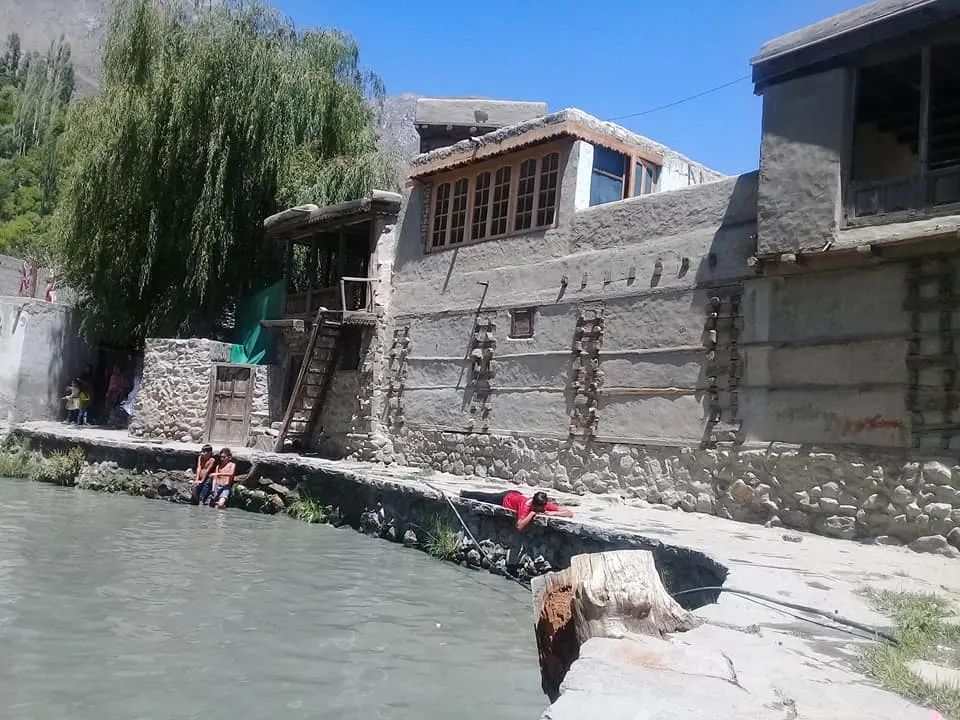
Ganish Village is the oldest known settlement in the valley, over 1,000 years old. The village is home to beautifully carved wooden mosques, watchtowers, and historic houses.
It has received several UNESCO awards for heritage conservation.
Wooden Mosques & Unique Architecture
- The village is home to 4 small wooden mosques, built between 100–200 years ago by different rulers, each wishing to be remembered.
- Their tiny size, beautiful wooden carvings, and quiet spiritual presence make them truly unique.
- Compact houses with low entrances helped keep homes warm in winter — livestock were kept close to trap heat and warn of intruders.
Why It’s Special:
- Ancient wooden architecture
- Peaceful walking trails through history
- Spiritual and cultural significance
Best Places in Hunza Valley for Nature Lovers
If you love breathtaking views, crystal-clear lakes, and towering peaks, these natural wonders offer peace, adventure, and unforgettable photo moments all in one place.
4- Attabad Lake – A Turquoise Gem Born from Tragedy

Formed after a massive landslide in 2010, Attabad Lake is now one of the most stunning spots in Hunza. The turquoise blue water against the rocky mountains creates a picture-perfect setting.
Tourists can enjoy boating, jet skiing, and lakeside resorts. In winter, the frozen lake turns into a snow-covered wonderland.
Activities:
- Jet ski & boating
- Lakeside camping
- Photography & drone shots
5- Passu Cones – The Majestic Cathedral Peaks
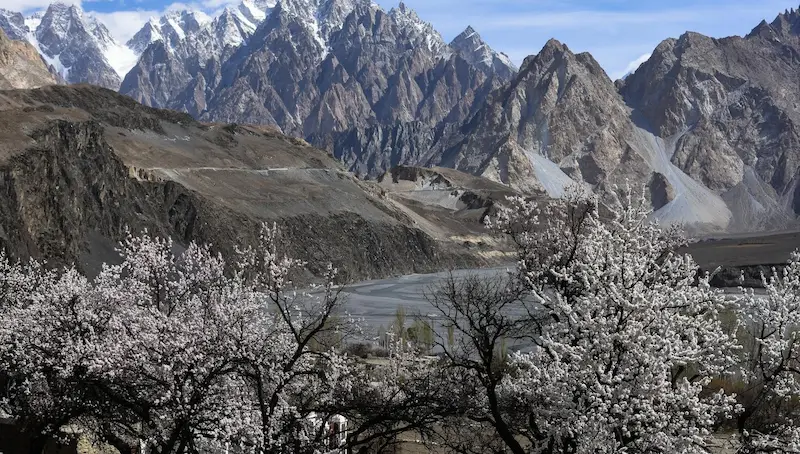
Passu Cones or Passu Cathedral are jagged, needle-like peaks that look straight out of a fantasy movie. Located in Upper Hunza (Gojal), they are among the most photographed mountains in Pakistan.
You can see them from the Karakoram Highway or hike closer to Passu Glacier for a thrilling experience.
Best For:
- Instagram-worthy photos
- Scenic drives and walks
- Glacier trekking nearby
6- Hopper Glacier – Nagar Valley Viewpoint
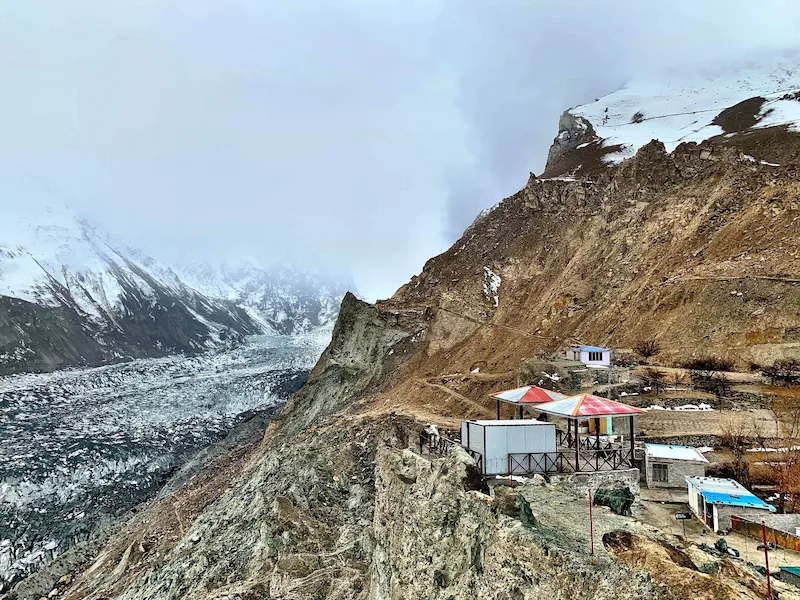
Just across Hunza River lies the Nagar Valley, home to Hopper Glacier. A short drive from Hunza, this glacier presents a rugged, icy landscape surrounded by high peaks like Spantik (Golden Peak).
Top Features:
- Glacial landscapes
- Panoramic mountain views
- Less crowded than other sites
Best Places in Hunza for Adventure Seekers
The following are the most exciting places in Hunza that offer rope bridges, hidden lakes, and wild valleys that are perfect for those who love fun, challenge, and adventure.
7- Hussaini Suspension Bridge – World’s Most Dangerous Bridge?
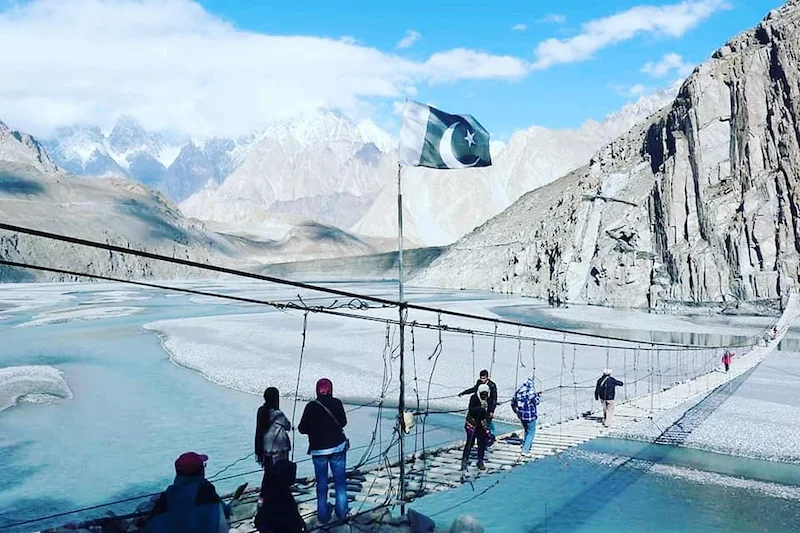
Located near Passu, the Hussaini Bridge is a rope bridge suspended over the Hunza River. With wooden planks spaced wide apart and the river roaring beneath, crossing it is a real test of courage.
Location & Access
- Located in Hussaini village, near Gulmit, Upper Hunza Valley
- Just a 10-minute walk from the main road
- Easy to reach via the Karakoram Highway
- Often visited as part of a loop trek that includes the Passu Suspension Bridge
How & Why It Was Built?
- Built by the local Hussaini community after floods washed away the old bridge
- Constructed entirely by hand
- Originally built for practical use — not tourism
- Still used today by villagers transporting goods and produce to Zarabad, a newer settlement across the river
What Makes It Special?
- Considered the second-longest man-made pedestrian suspension bridge in the world (the longest is believed to be in Canada)
- Crosses the Upper Hunza River, offering epic views of the Passu Cones
- A total of 472 wooden planks stretched across 660 feet (approx. 200 meters)
- Suspended about 50–100 feet above the river bed — gets scary when the wind blows or when others run across!
Who Should Try?
- Adventure seekers
- Backpackers and thrill-lovers
- Anyone with a strong heart!
8- Borith Lake – Hidden Gem for Hikers & Campers
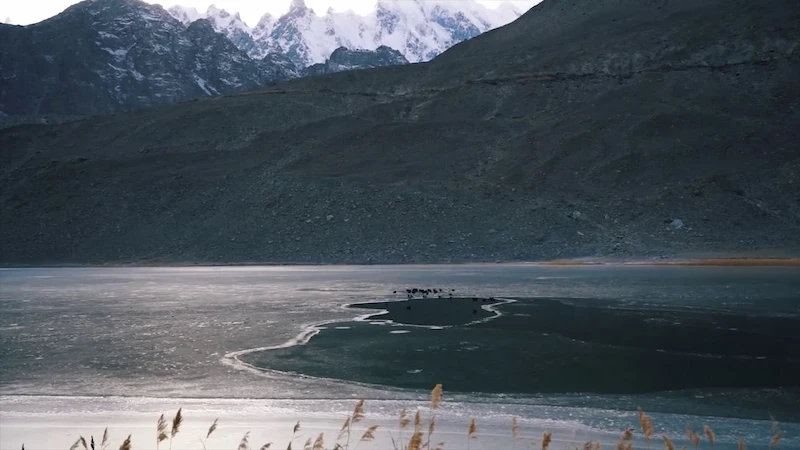
Borith Lake is a peaceful, lesser-known lake situated near Gulmit. It’s ideal for hikers and bird watchers, especially during spring and autumn when migratory birds visit.
Activities:
- Short hike from Hussaini village
- Camping by the lake
- Birdwatching paradise
- Hiking and trekking spots
Sanctuary for Migratory Birds
Borith Lake is an important sanctuary for migrating wildfowl, especially ducks. It draws bird-watchers and nature lovers, especially during:
- Spring Migration (March–June): Birds arrive from southern Pakistan on their way to Central Asia.
- Autumn Migration (September–November): The return journey as birds head south for winter.
This migratory cycle offers a rare glimpse into Pakistan’s biodiversity, making the lake a must-visit for wildlife enthusiasts.
Why Visit Borith Lake?
- Peaceful, off-the-beaten-path destination
- Close proximity to multiple glaciers and treks
- Ideal for photography, bird-watching, and nature retreats
- Authentic glimpse into the remote life of Upper Hunza
9- Shimshal Valley – Off-the-Beaten Path Adventure
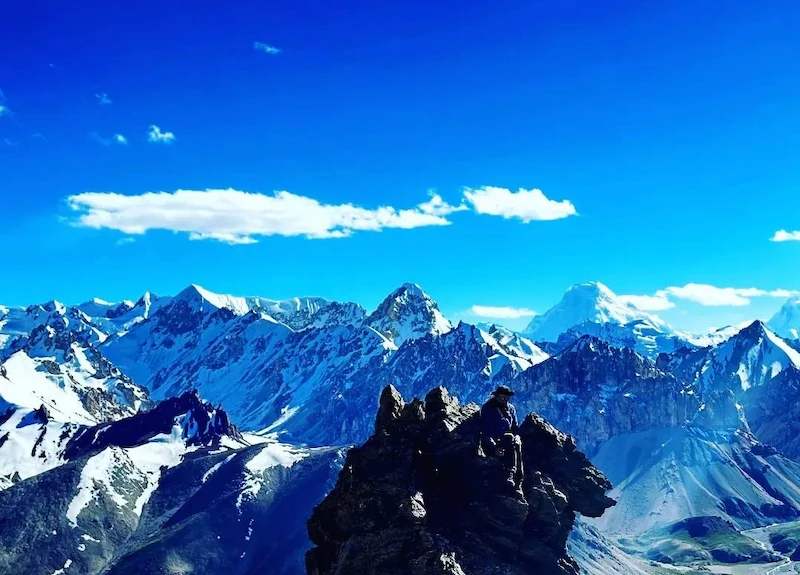
For true adventure lovers, Shimshal is unmatched. Accessible via a dramatic jeep track, this remote valley offers high-altitude trekking routes, glaciers, and authentic Wakhi culture.
Must-Know:
- Trekking to Shimshal Pass
- Wakhi hospitality and food
- Raw, untouched nature
Must-Visit Places in Hunza Valley
Hunza is full of beautiful spots that every traveler should see. From stunning viewpoints to cultural bazaars, these places give you the real taste of Hunza’s beauty and lifestyle.
10- Eagle’s Nest Viewpoint – Sunrise Spot Above Hunza
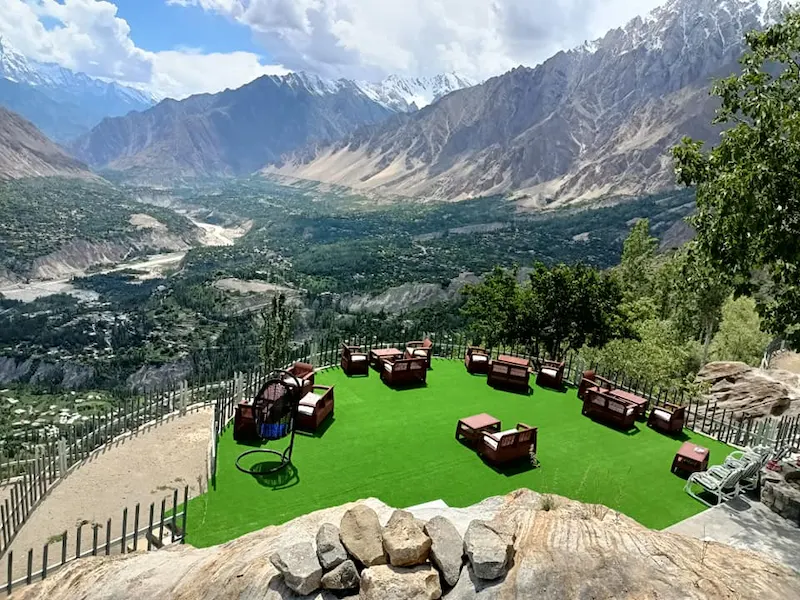
Located in Duikar village, Eagle’s Nest is the best place to watch sunrise and sunset in Hunza. From here, you can see multiple peaks including Ultar Sar, Ladyfinger, Rakaposhi, and Diran.
Why It’s Called “Eagle’s Nest”?
- Named for its eagle-eye vantage point, the viewpoint truly resembles where an eagle might perch.
- It offers commanding views over the Hunza Valley, much like an eagle soaring above its domain.
- From this point, you can witness 11+ towering snow-capped peaks, including:
- Rakaposhi (7,788 m)
- Ultar Sar (7,388 m)
- Ladyfinger Peak (6,000 m)
- Golden Peak (Spantik)
- Diran, Hunza Peak, and more.
The Magical Sunrise & Sunset
- Sunrise: The sky transforms into a palette of orange, pink, and gold, casting the first rays on Rakaposhi and Ultar.
- Sunset: The fading light turns the valley below into a soft golden canvas, perfect for peaceful reflection or romantic evenings.
- Especially popular among:
- Honeymooners seeking unforgettable views
- Photographers chasing golden hour magic
- Spiritual travelers appreciate the serenity of the moment
Unique Facts:
- Altitude: ~10,000 ft (3,050 m)
- Location: Duikar Village, Hunza
- Best Time to Visit: April to October
- Sunrise/Sunset: Ideal months are May–September for clear skies
- Nearby Peaks Visible: Rakaposhi, Ultar Sar, Ladyfinger, Spantik, Diran & more
Don’t Miss:
- Early morning photography
- Cozy cafes and hotels nearby
- View of the entire Hunza Valley
11- Duikar Village – Panoramic Views of the Hunza Valley
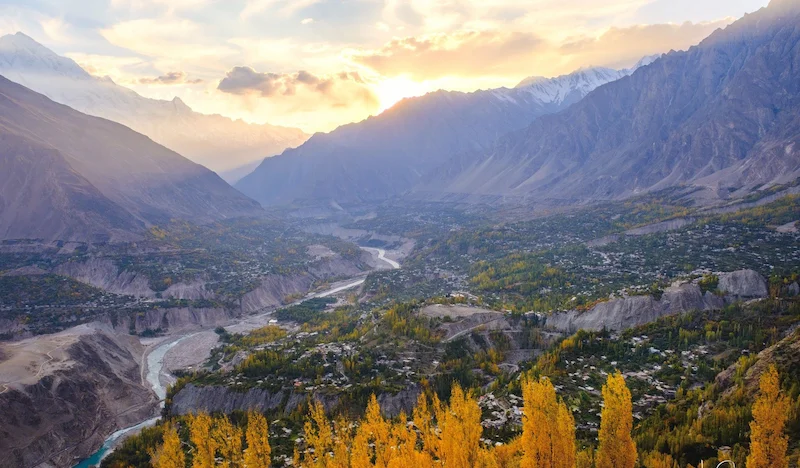
Duikar is a charming village that offers unbeatable views of the entire Hunza Valley. It’s peaceful and surrounded by orchards, making it an ideal retreat for nature lovers.
Why Duikar Is So Special?
- 360° Panoramic Views
- Sunrise & Sunset Point
- Stargazing Paradise
- Nature Lover’s Retreat
Ideal For:
- Photography: Capture iconic mountain panoramas and time-lapse sunsets.
- Hiking & Walks: Explore easy-to-moderate trails around the valley ridge.
- Overnight Stays: Experience local hospitality at family-run guesthouses or stay at the famed Eagle’s Nest Hotel.
- Cultural Interaction: Meet locals, share a cup of Hunza tea, and learn about traditional highland life.
- Peace & Solitude: Duikar is ideal for meditation, journaling, or simply breathing in the fresh mountain air.
12- Karimabad Bazaar – Local Handicrafts & Culture
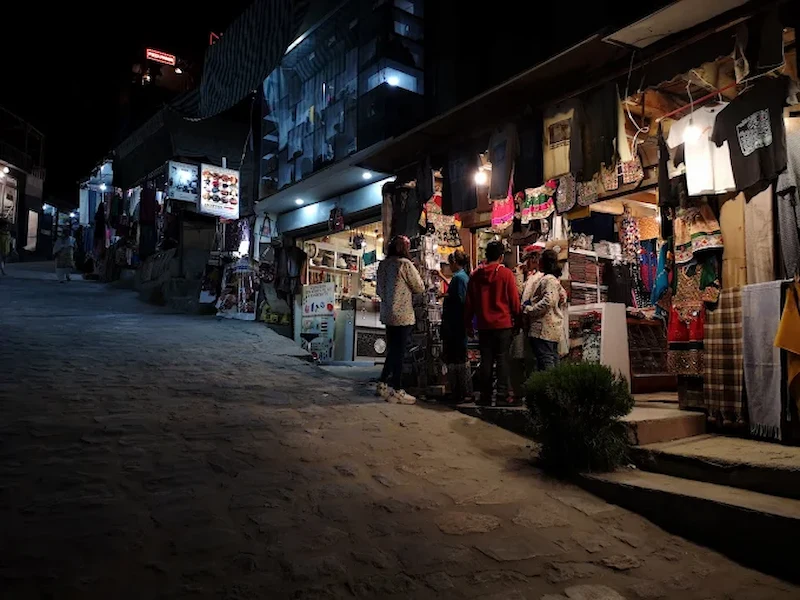
The heart of Hunza Valley, Karimabad is where tradition meets tourism. Its bazaar is full of handmade products like wool shawls, gemstones, apricot jams, and dried fruits.
What Makes Karimabad Bazaar Special?
- Local Handicrafts & Souvenirs
Discover handmade carpets, embroidered shawls, traditional Hunza caps, and locally-mined aquamarine gemstones, each piece a reflection of Hunza’s heritage. - Organic Food & Natural Products
Taste Hunza traditional foods or take home dried apricots, walnuts, herbal teas, apricot oil, and natural honey, grown and made by local farmers using centuries-old methods. - Traditional Hunza Attire
Find beautifully stitched regional clothing, hats, and accessories, known for their vibrant colors and cultural significance.
Why Visit?
- Local culture and interaction
- Food tasting (Hunza bread, apricot oil, walnut cake)
- Great for buying souvenirs
Tips for Visitors
- Bargain politely, especially for souvenirs and crafts.
- Support local shops that promote artisan-made products.
- Try local treats like walnut cake and apricot-based sweets.
- Don’t miss nearby forts, plan a full-day experience in Karimabad.
Seasonal Attractions and Best Time to Visit
Hunza is beautiful year-round, but your experience will vary by season and it is the best time to visit hunza:
- Spring (April-May): Cherry and apricot blossoms everywhere
- Summer (June-August): Best weather and all roads open
- Autumn (October): Golden trees and harvest festivals
- Winter (Dec-Feb): Snow-covered, peaceful, fewer tourists
Pro Tip: Cherry blossom and autumn foliage seasons are photographers’ favorites!
Conclusion:
Hunza Valley is more than just a travel destination – it’s a place of peace, adventure, culture, and unforgettable landscapes. From ancient forts to glacial lakes, from scenic villages to thrilling hikes, there is no shortage of beautiful and must-visit places in Hunza.
Whether you’re planning a short trip or a full cultural immersion, Hunza promises memories that will last a lifetime. So, don’t just hear about it, come and experience the magic of Hunza Valley yourself!
Ready to explore Hunza? Let us help you plan the perfect tour!
FAQs About Best Places to Visit in Hunza
What are the must-visit places in Hunza Valley?
The top attractions include Baltit Fort, Altit Fort, Attabad Lake, Passu Cones, Hussaini Suspension Bridge, Eagle’s Nest, Ganish Village, Borith Lake, Karimabad Bazaar, and Shimshal Valley.
Which is the most famous tourist spot in Hunza?
Attabad Lake is the most famous spot due to its stunning turquoise water and lakeside activities. Baltit Fort and Passu Cones are also globally recognized.
What is the best time to visit Hunza Valley?
Spring (April–May): Cherry and apricot blossoms.
Summer (June–August): Best weather and open roads.
Autumn (October): Golden leaves and harvest festivals.
Winter (Dec–Feb): Snowy but fewer facilities.
How many days are enough to explore Hunza Valley?
A 4–6 day trip is ideal to cover major attractions like Baltit Fort, Altit Fort, Attabad Lake, Passu Cones, and Eagle’s Nest, while also enjoying some relaxation.
Which historical places should I visit in Hunza?
Baltit Fort (700 years old), Altit Fort (over 1,100 years old), and Ganish Village (Hunza’s oldest settlement) are the top historical sites.
What are the best natural attractions in Hunza Valley?
Attabad Lake, Passu Cones, Hopper Glacier, Borith Lake, and Shimshal Valley are the top natural wonders offering scenic beauty and adventure.
Is Hunza Valley safe for tourists?
Yes, Hunza is considered one of the safest regions in Pakistan with friendly locals, low crime rates, and a welcoming environment for both local and foreign tourists.
What are the best places in Hunza for photography?
Eagle’s Nest (sunrise/sunset views), Attabad Lake (turquoise waters), Passu Cones (iconic peaks), and Karimabad (valley views with forts) are favorites for photographers.
What adventure activities can I do in Hunza Valley?
Crossing Hussaini Suspension Bridge
Trekking to glaciers (Passu & Hopper)
Boating at Attabad Lake
Hiking in Shimshal Valley
Camping near Borith Lake
Can I visit Hunza Valley in winter?
Yes, but expect limited hotel and road access. Winter offers snow-covered landscapes, fewer tourists, and a peaceful environment — perfect for those who enjoy serenity.


